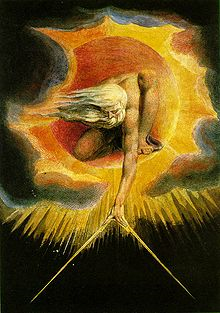
Yet as science and religion fight their age-old ideological war, another monism sits on the sidelines ignored by all, namely virtualism (Raspanti, 2000), that the physical world is generated by some other. The idea seems new but actually traces back to Plato’s idealism, that the world reflects another reality. Pythagoras called numbers the non-material essence of the world, Plato felt that God geometrizes, and Gauss believed that God does arithmetic (Svozil, 2005), just as Blake’s Ancient of Days measures the world with his compass (Figure 1.1).
Our computers create virtual worlds but that our world is virtual is usually a topic of fiction, not physics. It leads to ideas like that space calculates (Zuse, 1969) and that reality computes (Fredkin, 1990), (Schmidhuber, 1997), (Rhodes, 2001), (Wolfram, 2002), (Lloyd, 2006), and (Tegmark, 2007). Plato’s idealism is just as radical today as it was over two thousand years ago.
The issue is whether the physical world exists in and of itself alone, or whether something else causes it. The physical world as an objective reality needs nothing but itself to exist, so the prime axiom of current physics is that:
There is nothing outside the physical universe (Smolin, 2001).
In contrast, virtualism proposes its antithesis, that:
Nothing in the physical universe exists objectively, i.e. of or by itself.
These are mutually exclusive theses, as an objective world can’t be virtual and a virtual world can’t be objective. The virtual reality conjecture is essentially that:
The physical world is a set of events output by some other, without which it would not exist at all.
Physical realism in contrast proposes that the physical world is an objective reality that exists in and of itself, that needs nothing other than itself to exist.
Reality theories can’t be logically proven (Esfeld, 2004), so that the world is virtual isn’t certain, but physical realism isn’t certain for the same reason, and to demand of one theory what another can’t provide is bias. The unbiased way is to compare the evidence for both views impartially.